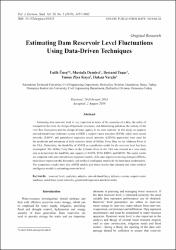| dc.contributor.author | Üneş, Fatih | |
| dc.contributor.author | Demirci, Mustafa | |
| dc.contributor.author | Taşar, Bestami | |
| dc.contributor.author | Kaya, Yunus Ziya | |
| dc.contributor.author | Varçin, Hakan | |
| dc.date.accessioned | 12.07.201910:50:10 | |
| dc.date.accessioned | 2019-07-12T22:05:55Z | |
| dc.date.available | 12.07.201910:50:10 | |
| dc.date.available | 2019-07-12T22:05:55Z | |
| dc.date.issued | 2019 | |
| dc.identifier.citation | Unes, F., Demirci, M., Tasar, B., Kaya, Y. Z., Varcin, H. (2019). Estimating dam reservoir level fluctuations using data-driven techniques. Polish Journal of Environmental Studies, 28(5), 3451-3462. doi: 10.15244/pjoes/93923 | en_US |
| dc.identifier.issn | 1230-1485 | |
| dc.identifier.issn | 2083-5906 | |
| dc.identifier.uri | https://doi.org/10.15244/pjoes/93923 | |
| dc.identifier.uri | https://hdl.handle.net/20.500.12508/587 | |
| dc.description | WOS: 000469277000041 | en_US |
| dc.description | Science Citation Index Expanded | en_US |
| dc.description.abstract | Estimating dam reservoir level is very important in terms of the operation of a dam, the safety of transport in the river, the design of hydraulic structures, and determining pollution, the salinity of the river flow fluctuations and the change of water quality in the dam reservoir. In this study, an adaptive network-based fuzzy inference system (ANFIS), support vector machines (SVM), radial basis neural networks (RBNN) and generalized regression neural networks (GRNN) approaches were used for the prediction and estimation of daily reservoir levels of Millers Ferry Dam on the Alabama River in the USA. Particularly, the feasibility of ANFIS as a prediction model for the reservoir level has been investigated. The Millers Ferry Dam on the Alabama River in the USA was selected as a case study area to demonstrate the feasibility and capacity of ANFIS, SVM, RBNN, and GRNN. The model results are compared with conventional auto-regressive models (AR), auto-regressive moving average (ARMA), multi-linear regression (MLR) models, and artificial intelligence models for the best-input combinations. The comparison results show that ANFIS models give better results than classical and other artificial intelligence models in estimating reservoir level. | en_US |
| dc.language.iso | eng | en_US |
| dc.publisher | Hard | en_US |
| dc.relation.isversionof | 10.15244/pjoes/93923 | en_US |
| dc.rights | info:eu-repo/semantics/openAccess | en_US |
| dc.subject | Reservoir Level | en_US |
| dc.subject | Prediction | en_US |
| dc.subject | Adaptive Network-Based Fuzzy Inference System | en_US |
| dc.subject | Support Vector Machines | en_US |
| dc.subject | Radial Basis Neural Networks | en_US |
| dc.subject | Generalized Regression Neural Networks | en_US |
| dc.subject.classification | Environmental Sciences | en_US |
| dc.subject.other | Prediction | en_US |
| dc.subject.other | Fuzzy | en_US |
| dc.subject.other | Networks | en_US |
| dc.title | Estimating dam reservoir level fluctuations using data-driven techniques | en_US |
| dc.type | article | en_US |
| dc.relation.journal | Polish Journal of Environmental Studies | en_US |
| dc.contributor.department | Mühendislik ve Doğa Bilimleri Fakültesi | en_US |
| dc.identifier.volume | 28 | en_US |
| dc.identifier.issue | 5 | en_US |
| dc.identifier.startpage | 3451 | en_US |
| dc.identifier.endpage | 3462 | en_US |
| dc.relation.publicationcategory | Makale - Uluslararası Hakemli Dergi - Kurum Öğretim Elemanı | en_US |
| dc.contributor.isteauthor | Üneş, Fatih | |
| dc.contributor.isteauthor | Demirci, Mustafa | |
| dc.contributor.isteauthor | Taşar, Bestami | |
| dc.contributor.isteauthor | Varçin, Hakan | |
| dc.relation.index | Web of Science | en_US |
















